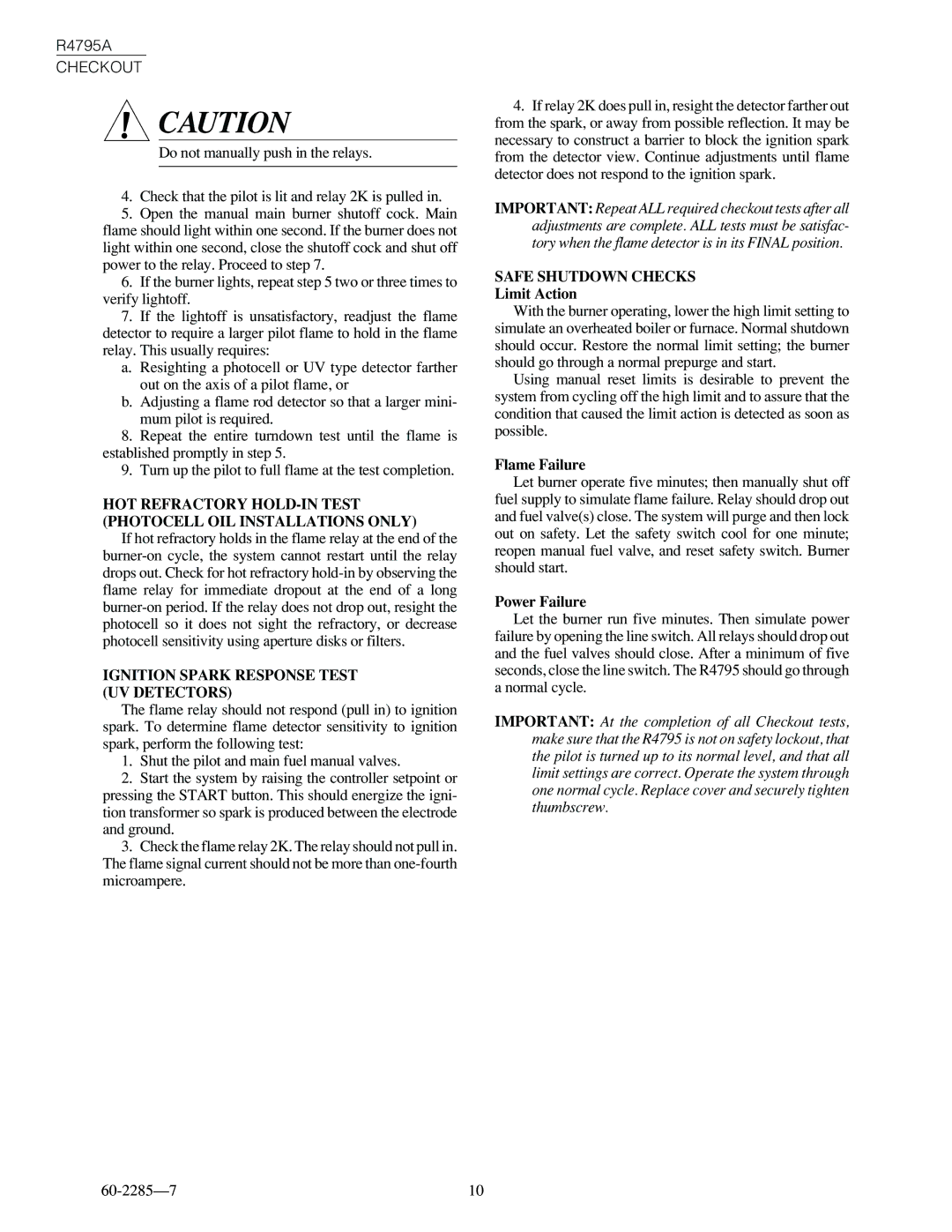
R4795A
CHECKOUT
![]() CAUTION
CAUTION
Do not manually push in the relays.
4.Check that the pilot is lit and relay 2K is pulled in.
5.Open the manual main burner shutoff cock. Main flame should light within one second. If the burner does not light within one second, close the shutoff cock and shut off power to the relay. Proceed to step 7.
6.If the burner lights, repeat step 5 two or three times to verify lightoff.
7.If the lightoff is unsatisfactory, readjust the flame detector to require a larger pilot flame to hold in the flame relay. This usually requires:
a. Resighting a photocell or UV type detector farther out on the axis of a pilot flame, or
b. Adjusting a flame rod detector so that a larger mini- mum pilot is required.
8.Repeat the entire turndown test until the flame is established promptly in step 5.
9.Turn up the pilot to full flame at the test completion.
HOT REFRACTORY
If hot refractory holds in the flame relay at the end of the
IGNITION SPARK RESPONSE TEST (UV DETECTORS)
The flame relay should not respond (pull in) to ignition spark. To determine flame detector sensitivity to ignition spark, perform the following test:
1.Shut the pilot and main fuel manual valves.
2.Start the system by raising the controller setpoint or pressing the START button. This should energize the igni- tion transformer so spark is produced between the electrode and ground.
3.Check the flame relay 2K. The relay should not pull in. The flame signal current should not be more than
4.If relay 2K does pull in, resight the detector farther out from the spark, or away from possible reflection. It may be necessary to construct a barrier to block the ignition spark from the detector view. Continue adjustments until flame detector does not respond to the ignition spark.
IMPORTANT: Repeat ALL required checkout tests after all adjustments are complete. ALL tests must be satisfac- tory when the flame detector is in its FINAL position.
SAFE SHUTDOWN CHECKS
Limit Action
With the burner operating, lower the high limit setting to simulate an overheated boiler or furnace. Normal shutdown should occur. Restore the normal limit setting; the burner should go through a normal prepurge and start.
Using manual reset limits is desirable to prevent the system from cycling off the high limit and to assure that the condition that caused the limit action is detected as soon as possible.
Flame Failure
Let burner operate five minutes; then manually shut off fuel supply to simulate flame failure. Relay should drop out and fuel valve(s) close. The system will purge and then lock out on safety. Let the safety switch cool for one minute; reopen manual fuel valve, and reset safety switch. Burner should start.
Power Failure
Let the burner run five minutes. Then simulate power failure by opening the line switch. All relays should drop out and the fuel valves should close. After a minimum of five seconds, close the line switch. The R4795 should go through a normal cycle.
IMPORTANT: At the completion of all Checkout tests, make sure that the R4795 is not on safety lockout, that the pilot is turned up to its normal level, and that all limit settings are correct. Operate the system through one normal cycle. Replace cover and securely tighten thumbscrew.
10 |
